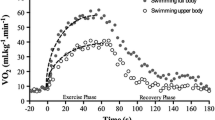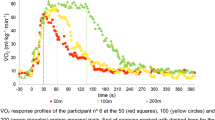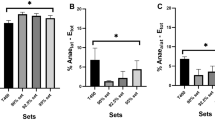Summary
The purpose of this investigation was to determine whether the critical swimming velocity (ν crit), which is employed in competitive swimming, corresponds to the exercise intensity at maximal lactate steady state.ν crit is defined as the swimming velocity which could theoretically be maintained forever without exhaustion and expression as the slope of a regression line between swimming distances covered and the corresponding times. A total of eight swimmers were instructed to swim two different distances (200 m and 400 m) at maximal effort and the time taken to swim each distance was measured. In the present study,ν crit is calculated as the slope of the line connecting the two times required to swim 200 m and 400 m. vcrit determined by this new simple method was correlated significantly with swimming velocity at 4 mmol · 1−1 of blood lactate concentration (r = 0.914,P < 0.01) and mean velocity in the 400m freestyle (r = 0.977,P < 0.01). In the maximal lactate steady-state test, the subjects were instructed to swim 1600 m (4 x 400 m) freestyle at three constant velocities (98010, 100% and 102070 ofν crit). At 100%ν crit blood lactate concentration showed a steady-state level of approximately 3.2 mmol · 1− from the first to the third stage and at 98% ofν crit lactate concentration had a tendency to decrease significantly at the fourth stage. On the other hand, at 102% ofν crit, blood lactate concentration increased progressively and those of the third and fourth stages were significantly higher than those at 100% ofν crit (P<0.05). These data suggest thatν crit, which can be calculated by performing two timed, maximal effort swimming tests, may correspond to the exercise intensity at maximal lactate steady state.
Similar content being viewed by others
References
Allen WK, Seals DR, Hurley B, Ehsani AA, Hagberg JM (1985) Lactate threshold and distance running performance in young and old endurance athletes. J Appl Physiol 58:1281–1284
Chassain AP (1986) Méthode d'appréciation objective de la tolérance de l'organisme à l'effort: application à la mesure des puissances critiques de la fréquence cardiaque et de la lactatémie. Sci Sports 1:41–48
Costill D, Kovaleski J, Porter D, Kirwan J, Fielding R, King D (1985) Energy expenditure during front crawl swimming: predicting success in middle-distance events. Int J Sports Med 6:266–270
deVries HA, Moritani T, Nagata A, Magnussen K (1982) The relation between critical power and neuromuscular fatigue as estimated from electromyographic data. Ergonomics 25:783–791
Ettema (1966) Limits of human performance and energy-production. Int Z Angew Physiol Einschl Arbeitsphysiol 22:45–54
Freund H, Oyono-Enguelle S, Heitz A, Marbach J, Ott C, Zouloumian P, Lampert E (1986) Work rate-dependent lactate kinetics after exercise in humans. J Appl Physiol 61:932–939
Heck H, Mader A, Hess G, Mucke S, Muller R, Hollmann W (1985) Justification of the 4 mmol/l lactate threshold. Int J Sports Med 6:117–130
Holmer I (1983) Energetics and mechanical work in swimming. In: Hollander AP, Huijing PA, Groot GD (eds) Biomechanics and medicine in swimming. Human Kinetics, Champaign, Ill., pp 154–164
Houston M (1978) Metabolic responses to exercise, with special reference to training and competition in swimming. In: Eriksson BO, Furberg B (eds) Swimming medicine IV. University Park Press, Baltimore, pp 207–232
Jenkins DG, Quigley BM (1990) Blood lactate in trained cyclists during cycle ergometry at critical power. Eur J Appl Physiol 61:278–283
Mader A, Heck H (1986) A theory of the metabolic origin of anaerobic threshold. Int J Sports Med 7:45–65
Mader A, Heck H, Liesen H, Hollmann W (1980) Zur Beurteilung der laktaziden Energiebereitstellung für Trainings- und Wettkampfleistungen im Sportschwimmen. Leistungssport 10:263–268
Madsen O, Lohberg M (1987) The lowdown on lactates. Swimming Techn 24:21–26
Maglischo EW, Maglischo CW, Bishop RA (1982) Lactate testing for training pace. Swimming Techn 19:31–37
Monod H, Scherrer J (1965) The work capacity of a synergic muscular group. Ergonomics 8:329–337
Moritani T, Nagata A, deVries HA, Muro M (1981) Critical power as a measure of physical work capacity and anaerobic threshold. Ergonomics 24:339–350
Nagata A, Moritani T, Muro M (1983) Critical power as a measure of muscular fatigue and anaerobic threshold. In: Matsui H, Kobayashi K (eds) Biomechanics VIIIA. Human Kinetics, Champaign, Ill., pp 312–320
Olbrecht J, Madsen O, Mader A, Liesen H, Hollmann W (1985) Relationship between swimming velocity and lactic concentration during continuous and intermittent training exercises. Int J Sports Med 6:74–77
Scheen A, Juchmes J, Cession-Fossion A (1981) Critical analysis of the “Anaerobic Threshold” during exercise at constant workloads. Eur J Appl Physiol 46:367–377
Sid-Ali B, Vandewalle H, Chair K, Moreaux A, Monod H (1991) Lactate steady state velocity and distance-exhaustion time relationship in running. Arch Int Physiol Biochim 99:297–301
Skinner J (1987) The new, metal-plated assistant coach. Swimming Techn 24:7–12
Stegmann H, Kindermann W (1982) Comparison of prolonged exercise tests at the individual anaerobic threshold and fixed anaerobic threshold of 4 mmol/L lactate. Int J Sports Med 3:105–110
Stegmann H, Kindermann W, Schnabel A (1981) Lactate kinetics as individual anaerobic threshold. Int J Sports Med 2:160–165
Wakayoshi K, Ikuta K, Yoshida T, Udo M, Moritani T, Mulch Y, Miyashita M (1992a) The determination and validity of critical speed as swimming performance index in the competitive swimmer. Eur J Appl Physiol 64:153–157
Wakayoshi K, Yoshida T, Udo M, Kasai T, Moritani T, Mutoh Y, Miyashita M (1992b) The simple method for determining critical speed as swimming fatigue threshold in competitive swimming. Int J Sports Med 13:367–371
Yamamoto Y, Miyashita M, Hughson R, Tamura S, Shinohara M, Mutoh Y (1991) The ventilatory threshold gives maximal lactate steady state. Eur J Appl Physiol 63:55–59
Author information
Authors and Affiliations
Rights and permissions
About this article
Cite this article
Wakayoshi, K., Yoshida, T., Udo, M. et al. Does critical swimming velocity represent exercise intensity at maximal lactate steady state?. Europ. J. Appl. Physiol. 66, 90–95 (1993). https://doi.org/10.1007/BF00863406
Accepted:
Issue Date:
DOI: https://doi.org/10.1007/BF00863406




